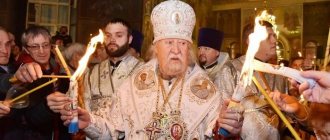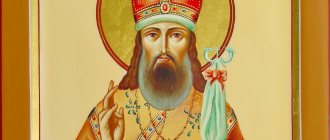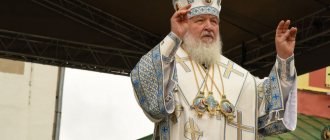Orthodox encyclopedia in online version
The Orthodox Encyclopedia is the largest scientific publishing project not only in the history of the Russian Orthodox Church, but also in the history of world Orthodoxy. Since 2007, the portal www.pravenc.ru has hosted an electronic version of the Orthodox Encyclopedia, which is visited monthly by more than 200 thousand users in Russia and abroad.
At the beginning of the 20th century, an attempt was made to create a similar project - the Orthodox Theological Encyclopedia. In many ways, the publication relied on Western models, but in 1911 its publication was discontinued on the 12th volume.
The idea to create an Orthodox Encyclopedia - a systematic body of knowledge on all aspects of Christian and church life in its history and modernity (theology, history, liturgics, etc.) - belonged to Patriarch Alexy II of Moscow and All Rus' and was first proposed in 1996 . The prerequisite for the implementation of such a grandiose work was the publication of the “History of the Russian Church” by Metropolitan Macarius (Bulgakov) by the scientific publishing house of the Spaso-Preobrazhensky Valaam Monastery. This 12-volume publication, dedicated to the history of Orthodoxy in Rus', became the first and very successful experience of interaction between church and secular science in joint work on a unique scientific publishing project. And it was this success that allowed Alexy II to express hope for the implementation of a new, even more ambitious project - the creation of an Orthodox Encyclopedia.
Monument to Saint Macarius (Bulgakov), Metropolitan of Moscow and Kolomna, native of Saint Belogorye, in Belgorod. Photo: A. Shapovalov / photobank “Lori”
Meeting of the Board of Trustees of the Church-Scientific Church in the Cathedral of Christ the Savior, May 31, 2005. Photo: www.patriarchia.ru
In the same 1996, the publishing house of the Spaso-Preobrazhensky Valaam Monastery was transformed into a Church Scientific Publishing House and, upon completion of work on the last, 12th volume of the “History of the Russian Church,” began work on the dictionaries of the future encyclopedia. In addition to the already involved historians (specialists in Russian history), leading secular scientists in all spectrums of the humanities began to work on the creation of dictionaries.
In 2000, the first volume dedicated to the Russian Orthodox Church was published. Since 2001, alphabetical volumes began to be published. Initially, two volumes were published per year, then three volumes; now the Church Scientific Center publishes four volumes annually. By the end of 2015, 40 alphabetical volumes had been published.
Valaam Monastery. Photo: Y. Sinitsyna / photobank “Lori”
Monastic shop, Valaam. Photo: A. Shchepin / photobank “Lori”
Over the years, the Orthodox Encyclopedia has become a leading scientific publication not only in the field of Christianity, but also in history, art history, philosophy, and music. Articles in the Orthodox Encyclopedia are notable not only for their detailed descriptions of historical places, organizations, events or persons, but also for their in-depth analysis of research subjects. More than 80% of the information is published in Russian for the first time, and in this sense, the Orthodox Encyclopedia combines the functions of education and scientific research. Some articles from the Orthodox Encyclopedia, united by content, are published in separate publications, for example, the book “Ecumenical Councils” (Russia), the brochure “Jerusalem Orthodox Church” (Israel).
Russian Orthodox Church
The Church-Scientific Center has published the next, 61st volume of the “Orthodox Encyclopedia”. The new volume continues the publication of articles starting with the letter “C”. This publication opens with an article about the bishop of the Old Believer Belokrinitsa diocese, Archbishop of Moscow and Vladimir Savatiy (Stefan Levshin), and the volume ends with material about the famous Swedish scientist and spiritual seer Emanuel Swedenborg.
A special place in the volume belongs to the topic of St. Petersburg, the article about which contains a detailed historical outline. Separate articles are devoted to the St. Petersburg Metropolis, as well as the St. Petersburg and Ladoga Diocese. Considerable attention is paid to the Old Believer communities of the Northern capital, the position of the Armenian Apostolic Church, as well as the Roman Catholic Church, Anglicans, Lutherans, Reformed and representatives of many other faiths. The volume contains an article about the history of the St. Petersburg Theological Academy (SPbDA) - a unique educational institution, the ancestor of which was the Slavic school, which operated since 1721. The reader will be able to learn a lot about the professors who worked at SPbDA, the organization of the educational process, the teaching of theological, philosophical and historical disciplines, and the activities of the departments. The volume included articles about the St. Petersburg Trinity-Sergius Monastery, the convent of St. John of Rilsky in St. Petersburg, and the Smolny Novodevichy Convent.
Another important Russian city that receives attention in Volume 61 is Samara. A detailed article is devoted to the history of the Samara and Novokuybyshev diocese. The authors of the material paid considerable attention to issues of missionary work in the diocese, issues of church charity and service. In the article about the Samara region, significant attention is paid to the history of various faiths and church architecture. The volume also contains articles about the Samara Monastery in honor of the Resurrection of Christ, the Samara Monastery in honor of the Iveron Icon of the Mother of God, and the Samara Desert Monastery in honor of St. Nicholas.
The topic is continued by an article about the Saratov and Volsk diocese. At the beginning of 2021, there were 6 monasteries and 177 parishes operating here. The history of the diocese in the 19th century, book publishing and church journalism, the tragic events that took place here after the advent of Soviet power, and the successes of church construction in the modern period are examined. The history of various faiths is discussed in the article about the Saratov region.
It is also necessary to note the materials about the Saransk and Sarapul dioceses, which describe shrines and religious processions in the dioceses, tell about their history, provide lists of monasteries and talk about their bishops.
The Far Eastern theme is also reflected in the volume - the publication contains an article about the Republic of Sakha, which includes sections on the Bahai religion and the cult of Aar Aiyy, based on the heroic epic Olonkho. No less interesting is the material about the Sakhalin region, which, in particular, talks in detail about church architecture and the crisis of shamanism among the Ainu and Nivkhs.
The volume also contains an article about the San Francisco and Western American Diocese of the Russian Church Abroad, which includes parishes in many Western American states and Mexico. Cathedrals are located in San Francisco, Los Angeles and Seattle.
The new edition contains a detailed article about Saudi Arabia, a theocratic monarchy whose king represents the power of the Saudi family. The basis of the law and order here is the Koran and Sharia in the interpretation of the Hanbali madhhab; conversion to Christianity is still punishable by death. Interesting articles about other countries - El Salvador, Sao Tome and Principe, San Marino.
The reader will also be able to learn about a number of unique architectural objects: the Chapel of San Venanzio in the Lateran complex of Rome; the Church of San Vitale in Ravenna, which preserves mosaics from the time of Emperor Justinian; the Neapolitan Baptistery of San Giovanni in Fonte, the male Benedictine Abbey of St. Gallen; the Papal Basilica of San Paolo Fuori le Mura, which still enjoys the right of extraterritoriality; Mausoleum of the 4th century Santa Costanza, converted into a church; the pilgrimage basilica of Santa Croce in Gerusalemme, founded by Equal-to-the-Apostles Constantine the Great; the Roman church of Santa Maria Antiqua, which probably served the Greek community in Rome; Santa Maria Assunta - one of the most ancient and famous buildings in Venice on the island of Torcello; Santa Maria del Fiore - the cathedral of Florence, certainly one of the most beautiful buildings in the world.
The volume's personalities section is also quite extensive. The volume contains articles about saints and martyrs named Savva, including St. Savva Vishera, founder of the Vishera Monastery, St. Savva of Moscow, founder of the Andronikov Monastery, about the disciple of St. Sergius of Radonezh to Savva Stromynsky, student of St. Sergius of Radonezh, founder of St. Savvin Storozhevsky Monastery, St. Savva of Storozhevsky, Patriarchs of Alexandria and Jerusalem with the name Savva. The pages of the 61st volume of the encyclopedia also contain articles about Metropolitan Savva of Warsaw and All Poland, Metropolitan Savva Petrovich-Njegosh of Montenegro, Bishop Savva of Zelenograd and one of the largest religious, cultural and political figures in Serbian history, Archbishop Savva of Serbia (in the world Rastko Nemanjic) . A separate article in the volume is devoted to the Lavra of Saint Sava, the oldest communal desert located in Israel.
Among other outstanding figures whose biographies are present in the volume, it should be noted the Italian Girolamo Savonarola, the Catholic polemicist Cassian Sakovich, the Chief Prosecutor of the Holy Governing Synod Alexander Samarin, the outstanding Slavophile Yuri Samarin, the Italian composer Giuseppe Sarti.
The new edition includes detailed biographies of the righteous wife of Abraham Sarah, the Old Testament fighter against the Philistines, judge Samson, as well as a description of the Sarov desert in honor of the Dormition of the Most Holy Theotokos. Middle Eastern experts will be interested in the material about the Samaritans.
Traditionally, articles in the Orthodox Encyclopedia are accompanied by extensive illustrative material - color maps and numerous photographic reproductions of portraits and works of church art.
The volume is available at the bookstore-store and in the exhibition hall of the Orthodox Encyclopedia Central Scientific Center.
Sedmitsa.ru/ Patriarchy.ru
What should a Christian school be like? Travel to Yalta. Boris Godunov. Continuing the conversation
29.05.2021
What should a Christian school be like? Conversation between priest Alexy Uminsky and the guests of the program. Travel to Yalta. We will see the Church of St. John Chrysostom and learn the history of St. Demetrius Kiranov, who served as rector of this temple during the years of persecution of the 20th century. Boris Godunov. Continuing the conversation. Elimination of competitors and death of Tsarevich Dimitri. Who needed it?
Watch episode »
Pages: 1next >
The priest's children are in full view of the parish. Travel to Alupka. Khrushchev's persecution of the church
05.06.2021
The priest's children are in full view of the parish. Conversation between priest Alexy Uminsky and studio guests. Travel to Alupka. We will see the famous Vorontsov Palace and learn the history of St. Vladimir of Troepol, the founder of the local temple of the Archangel Michael. Khrushchev's persecution of the church. The time of Nikita Khrushchev is the exposure of Stalin’s personality cult and the “thaw” in cultural life. But under him, a new oppression of the church began. Why did this happen?
Watch episode »
What does it mean to be successful? Travel to Galich. Union of Brest 1596
26.06.2021
What does it mean to be successful? How much does our faith contribute to success or, conversely, is it an obstacle? Travel to Galich. We will visit a city with a rich history and find out why the cross of St. John the Baptist appeared on the coat of arms of Galich in ancient times. Union of Brest 1596. Who was its initiator? And how did it affect relations between Catholics and Orthodox?
Watch episode »
Traffic
| A country | Place in countries | Visitors % | Page views % |
| Russia | 6840 | 74.88% | 76.44% |
| Kazakhstan | 73049 | 1.09% | 0.89% |
| India | 8731915 | 0.81% | 1% |
| Russia, Kazakhstan, India are the most popular countries. | |||
| Region | Place in the region | Visitors % | Page views % |
| Sakha (Yakutia) | 4856 | 0.64% | 0.36% |
| Oryol Region | 4924 | 0.2% | 0.69% |
| Orenburg region | 5061 | 0.57% | 0.47% |
| Kamchatka Krai | 5198 | 0.86% | 0.13% |
| Voronezh region | 5266 | 1.05% | 0.4% |
| Kemerovo region | 5335 | 0.44% | 0.18% |
| Transbaikal region | 5403 | 0.99% | 0.35% |
| Samara Region | 5540 | 0.24% | 0.32% |
| Irkutsk region | 5608 | 0.37% | 0.29% |
| Krasnoyarsk region | 5745 | 0.27% | 0.69% |
| Rostov region | 5814 | 0.84% | 0.67% |
| Smolensk region | 6019 | 0.79% | 0.23% |
| Lipetsk region | 6224 | 0.85% | 0.61% |
| Magadan Region | 6498 | 0.21% | 0.71% |
| Tomsk region | 6566 | 0.38% | 0.89% |
| Mordovia | 6703 | 0.78% | 0.4% |
| Tula region | 6908 | 0.58% | 0.83% |
| Vologda Region | 6976 | 0.75% | 1% |
| Jewish Autonomous Region | 7045 | 1.01% | 0.36% |
| Mari El | 7387 | 0.29% | 0.33% |
| Murmansk region | 7455 | 0.56% | 1.03% |
| Novgorod region | 7592 | 0.75% | 0.8% |
| Kaluga region | 7660 | 0.46% | 0.55% |
| Kursk region | 7729 | 0.36% | 0.21% |
| Moscow region | 7797 | 0.17% | 0.57% |
| Altai region | 7866 | 0.86% | 0.91% |
| Karelia | 8002 | 0.68% | 0.23% |
| Khanty-Mansi Autonomous Okrug - Yugra | 8071 | 0.64% | 0.29% |
| Crimea | 8208 | 0.22% | 0.72% |
| Kaliningrad region | 8276 | 0.19% | 0.7% |
| Nenets Autonomous Okrug | 8344 | 0.89% | 0.37% |
| Khakassia | 8413 | 0.83% | 0.33% |
| Adygea | 8550 | 1.05% | 0.41% |
| Dagestan | 8618 | 1.02% | 0.67% |
| Astrakhan region | 8686 | 0.32% | 0.78% |
| Ivanovo region | 8755 | 0.5% | 0.87% |
| Average statistics for the last 3 months | ||
| Place in the world | 166,195 | -11,019 |
| Monthly attendance | 401,490 | 6.63% |
| Position by monthly traffic | 166,171 | -11,017 |
| Page views per month | 1,011,750 | -3% |
| Position by page views | 356,299 | +10,689 |
| Page views by 1 visitor | 2.52 | — |
Good and evil in our life. Travel to the Vladychny Monastery. Khrushchev's persecution of the church
19.06.2021
Good and evil in our life. Continuation of the conversation between priest Alexy Uminsky and the guests of the program. Travel to the Vladychny Monastery. We will learn the history of the appearance of the miraculous icon of the Inexhaustible Chalice and see how the ancient monastic monastery is being revived in our days. Khrushchev's persecution of the church. Continuing the conversation. Church reform of 1961 and its consequences.
Watch episode »





